Marketplace Location Decision Making and Tourism Route Planning
Abstract
:1. Introduction
2. Literature Review
3. Problem Description and Mathematical Formulation
3.1. Data Collection
3.2. Mathematical Model
4. Adaptive Large Neighborhood Search Algorithm
4.1. ALNS Algorithm
| Algorithm 1: Adaptive Large Neighborhood Search (ALNS) algorithm of tourism route planning. |
| 1. Construct a feasible solution s; |
| 2. s*←s; |
| 3. Initialize weights; |
| 4. If the stopping criterion is not met, then |
| 4.1 Select q, r R, d D according to probabilities p |
| 4.2 s′ = r(d(s)) |
| 4.3 If the acceptance criterion is satisfied, then s←s′; |
| If s is better than s*, then s*←s′; |
| 4.4 Adjust weights; |
| 5. Return s*. |
- (1)
- The feasible solution initially generated is s.
- (2)
- The initial solution s is the best solution s*.
- (3)
- Determine the random probability initial weight for the destruction and reconstruction operator.
- (4)
- Repeat this procedure until stopped:
- 4.1
- Both the number of destruction d and repair r are selected by a random probability with a dependent weight value.
- 4.2
- The destruction d and repair r of current solution s is a creative new solution s′.
- 4.3
- If the current solution s indicates a new solution s′, this conforms to the acceptance condition.
- 4.4
- The weight is adjusted for the new solution when s is better than the last solution s*.
- (5)
- New solution s* is returns to step 3–5 for destruction and proceeds until a new best solution is created and then stops.
| Algorithm 2: Feasible solution construction. |
| 1. Lt <- {1, 2, …, n} travel places for construct travel routes |
| 1.1 Construct route r1 |
| 1.2 S = {r1} |
| 2. While L is not empty |
| 2.1 Randomly select travel place ct Lt |
| 2.2 Insert travel place ct at rk S; rk is the best feasible all route in the solution |
| 2.3 If there is no feasible solution, then create new route S |
| 2.4 Lt ← Lt − {ct} |
| 3. Lf <- {1, 2, …, m} farm places for construct suitable center |
| 4. While Lf is not empty |
| 4.1 Randomly select farm location cf Lf |
| 4.2 Assign farm cf to its best feasible depot in best route rk S |
| 4.3 Lf ← Lf − {cf} |
| 5. return S |
4.2. Destruction Methods
4.2.1. Random Removal
- Step 1
- The sort of TARR or FRR is selected randomly for sort destroying.
- Step 2
- The number of sort destroying is selected randomly for finding the number of point removals.
- Step 3
- If there is a random number of points, the operation removes the points from the route.
4.2.2. K-Route Removal
- Step 1
- A route is selected randomly from all the routes; the route randomly selected is one or more from route R S |R| = K.
- Step 2
- Determine A as an array of destination point R.
- Step 3
- Randomly select the removal method from all route removals.
- Step 4
- The route is selected from Step 1 is destroyed for finding L, where L is solution set to be removed.
4.2.3. Entire Route Removal
- Step 1
- A route is selected randomly from all the routes, where route random selection is one or more than route R S |R| ≥ 1.
- Step 2
- Determine if A is an array of destination point R.
- Step 3
- Route was selected for removal from all routes.
- Step 4
- A route is selected from Step 1 is destroyed for finding L, where L is the solution set to be removed.
4.2.4. Worst Removal
| Algorithm 3: Worst removal algorithm. |
| 1. L ← {}; |
| 2. While |L| < q do |
| 2.1 Array: A = an array containing all tourism attractions or farms request from s not in L; |
| 2.2 Sort A such that (i < j) → cost(A[i]) < cost(A[j]); |
| 2.3 Choose a random number x from the interval(0,1); |
| 2.4 L ← L {A[xp |A|]}; |
| 3. remove the requests in L from s; |
| 4. return L |
- Step 1
- The initiation is a vacant set.
- Step 2
- Find L by repeating this procedure completely for the number of q:
- 2.1
- Array A is a created number of all tourism attractions or farms but set L is untraceable.
- 2.2
- Array A member is sorted by using cost function removal.
- 2.3
- Random x is an interval in the range 0–1.
- 2.4
- A tourism attraction or farm is a selected value in array A, in which an attraction point is random. Then, add a tourism attraction point or farm point to the set of L, where the value p is a random weight. A low value of p corresponds to greater randomness.
- Step 3
- The member completely removes point L from the solution.
- Step 4
- Return L is Step 2, where L is found in the next iteration.
4.2.5. Related Removal
| Algorithm 4: Related removal algorithm. |
| 1. L ← {}; |
| 2. Random centroids p(lat,lng) |
| 3. While |L| < q, then |
| 3.1 Find ct is a nearly centroid tourism attraction point or farm point with Euclidean distance |
| 3.2 L ← L {ct}; |
| 3.3 Update centroids p(lat,lng) = centroids(L) = ; |
| 4. return L |
- Step 1
- A single tourism attraction position or single farm position is selected randomly from all the tourism attractions or farm locations, respectively, which is removed from the solution.
- Step 2
- The generated group set removal is an initial member ct.
- Step 3
- Finding L involves a repeated procedure for the number of q.
- 3.1
- One tourism attraction position or farm position is chosen at random from the set of L.
- 3.2
- Array A is a created member of all solutions but untraceable from set L.
- 3.3
- Array A member is sorted by using the function relation R(c1,c2) from less to more valuable. The defined relationship is a distance between c1 and c2 plus the opening time of destination c1,c2 finding from R(c1,c2) = α dist(c1,c2) + β|tac1 − tac2|.
- 3.4
- Random x is an interval ranging from 0–1.
- 3.5
- A point of tourism attraction or farm is a selected value in array A, of which the tourism attraction point or farm point is a random value. After that, the tourism attraction point or farm point is added to set L, where the value p is of random weight random, and a low value of p corresponds to greater randomness.
- Step 4
- When the member is completely removed, point L is the solution.
- Step 5
- Return L is Step 2, where L is found in the next iteration.
4.2.6. Cluster Removal
| Algorithm 5: Cluster removal algorithm. |
| 1. Randomly select a tourism attraction or farm ct and remove it from the solution; |
| 2. L ← {ct}; |
| 3. while |L| < q then |
| 3.1 c ← randomly select a travel place in L; |
| 3.2 Array: A = an array containing all request from s not in L; |
| 3.3 Sort A such that (i < j) → R(c,A[i]) < R(c,A[j]); |
| 3.4 Choose a random number x from the interval [0,1); |
| 3.5 L ← L {A[xp |A|]}; |
| 4. remove the requests in L from s; |
| 5. return L |
- Step 1
- The initiation is a vacant set.
- Step 2
- Randomly choose centroids for removal.
- Step 3
- Finding L was repeated for the number of q.
- 3.1
- Find point ct as a nearly centroid point using the Euclidian distance method.
- 3.2
- A point is added in set L.
- 3.3
- The updated centroid is an improvement in the solution route.
- Step 4
- Remove L from solution S.
- Step 5
- Return L is Step 2 that found L in the next iteration.
4.3. Repairing Operation
4.3.1. Greedy Insertion
- Step 1
- Determine S as a solution set member {r1, r2, ..., rk}.
- Step 2
- Repeat each rk S to find the difference in the lowest cost with insertion c into i of rk Δfc,k.
- Step 3
- The destination position is inserted into different lowest-cost routes of all routes, as shown in Equation (37):where c is the lowest cost, L is all positions not free, k is the destination number, and f is the different lowest value of the route.
4.3.2. Regret-H Insertion
4.3.3. Greedy Insertion with New Route Opening
- Step 1
- Total number of routes is determined as the highest number of routes.
- Step 2
- When the number of routes is less than the prescribed route:
- 2.1
- If the creative new route is less expensive than the cost of greedy insertion, the new route is created.
- 2.2
- Vise versa: if the creative new route is not better than the cost of greedy insertion, the greedy insertion is selected for insertion.
- Step 3
- If the new route is over prescribed, the greedy insertion is selected instead of a new route.
4.3.4. Two-Option Route Repairing
4.3.5. Exchange Route Repairing
4.4. Acceptance Criterion
5. Results and Discussion
6. Conclusions
Case Study
Author Contributions
Funding
Conflicts of Interest
Appendix A
| Order | Tourism Attraction | Latitude | Longitude | Open-Close Times |
|---|---|---|---|---|
| 0 | Rest | 19.925738 | 99.82364 | 8:00 a.m.–6:00 p.m. |
| 1 | Wat Rong Khun | 19.824285 | 99.763159 | 7:00 a.m.–6:00 p.m. |
| 2 | Boonrod farm | 19.852997 | 99.743386 | 6:00 a.m.–8:00 p.m. |
| 3 | Wat Phra Sing Chiang rai | 19.911672 | 99.830615 | 8.00 a.m.–6:00 p.m. |
| 4 | Wat Phra Kaew | 19.91171 | 99.827718 | 6:00 a.m.–6:00 p.m. |
| 5 | Wat Huai Pla Kha | 19.948406 | 99.806396 | 7:00 a.m.–6:00 p.m. |
| . . . . | . . . . | . . . . | . . . . | . . . . |
| 113 | Bak International Port | 20.275078 | 100.40596 | 8.00 a.m.–7:00 p.m. |
| 114 | Saturday Night Market | 20.25453 | 100.410303 | 4.00 a.m.–9.00 p.m. |
| 115 | Wat Luang | 20.043683 | 100.379802 | 8.00 a.m.–6:00 p.m. |
| Order | Farm | Latitude | Longitude |
|---|---|---|---|
| 1 | Mae Kao Tom | 20.009389 | 99.912778 |
| 2 | Mae Kon | 19.849194 | 99.732778 |
| 3 | Ban Du | 19.977111 | 99.831444 |
| 4 | Rim Kok | 19.985417 | 99.935472 |
| 5 | San Sai | 19.856694 | 99.815528 |
| . . . . | . . . . | . . . . | . . . . |
| 23 | San Klang | 19.592139 | 99.707333 |
| 24 | Pa Hung | 19.567889 | 99.702972 |
| 25 | Wiang Hao | 19.525389 | 99.85355 |
| Order | Parameter | Set |
|---|---|---|
| 1 | Attraction number | 1–115 |
| 2 | Farm number | 1–25 |
| 3 | Score | 1–10 |
| 4 | Level | 1–5 |
| 5 | Opening time | 180–510 min |
| 6 | Closing time | 1020–1380 min |
| 7 | Time spent at attraction | 60 min |
| Normality Testing | Problem Size | |||||
|---|---|---|---|---|---|---|
| Small | Medium | Large | ||||
| Lingo | ALNS | Lingo | ALNS | Lingo | ALNS | |
| p-value | 0.119 | 0.119 | 0.419 | 0.388 | 0.430 | 0.100 |
| Results | normal | normal | normal | normal | normal | normal |
| Cost Per Unit (Bath/km) | Route | Distance (km) | Traveling Cost (Bath) |
|---|---|---|---|
| 2.35 | 1 | 55.60 | 130.66 |
| 2 | 279.40 | 656.59 | |
| 3 | 379.80 | 892.53 | |
| 4 | 171.95 | 404.08 | |
| 5 | 119.63 | 281.13 | |
| 6 | 202.79 | 476.55 | |
| 7 | 209.70 | 492.79 | |
| 8 | 337.50 | 793.12 | |
| 9 | 184.40 | 433.34 | |
| 10 | 234.60 | 551.31 | |
| 11 | 201.85 | 474.34 | |
| 12 | 133.40 | 313.49 | |
| 13 | 27.40 | 64.39 | |
| Total | 2538.02 | 5964.34 | |
References
- Alfredo, Olivera, and Viera Omar. 2007. Adaptive memory programming for the vehicle routing problem with multiple trips. Computers & Operations Research 34: 28–47. [Google Scholar] [CrossRef]
- Alinaghian, Mahdi, and Nadia Shokouhi. 2018. Multi-depot multi-compartment vehicle routing problem, solved by a hybrid adaptive large neighborhood search. Omega 76: 85–99. [Google Scholar] [CrossRef]
- Andrades, Lidia, and Frederic Dimanche. 2017. Destination competitiveness and tourism development in Russia:Issues and challenges. Tourism Management 62: 360–76. [Google Scholar] [CrossRef]
- Azi, Nabila, Michel Gendreau, and Jean-Yves Potvin. 2014. An adaptive large neighborhood search for a vehicle routing problem with multiple routes. Computers & Operations Research 41: 167–73. [Google Scholar] [CrossRef]
- Boonya, Chanagan, and Warisa Wisittipanich. 2017. Mathematical Model for Tourist Routing Problem in a Capital District of Chiang Mai. Paper presented at IE Network 2017, Chiang Mai, Thailand, July 12–15; pp. 1028–33. (In Thai). [Google Scholar]
- Caroline, Prodhon, and Prins Christian. 2014. A survey of recent research on location-routing problems. European Journal of Operational Research 238: 1–17. [Google Scholar] [CrossRef]
- Chan, Lu, Eric Hsueh, Shih-Hsin Fang, and Vincent S. Tseng. 2016. Integrating tourist packages and tourist attractions for personalized trip planning based on travel constraints. Geoinformatica 20: 741–63. [Google Scholar] [CrossRef]
- Chen, Shifeng, Rong Chen, Gai-Ge Wang, Jian Gao, and Arun Kumar Sangaiah. 2018. An adaptive large neighborhood search heuristic for dynamic vehicle routing problems. Computers and Electrical Engineering 67: 596–607. [Google Scholar] [CrossRef]
- Dayarian, Iman, Teodor Gabriel Crainic, Michel Gendreau, and Welter Rei. 2016. An adaptive large-neighborhood search heuristic for a multi period vehicle routing problem. Transportation Research Part E 95: 95–123. [Google Scholar] [CrossRef]
- Flognfeldt, Thor, Jr. 2005. The tourist route system—Models of travelling patterns. Belgeo 1: 1–26. [Google Scholar] [CrossRef]
- Gavalas, Damianos, Charalampos Konstantopoulos, Konstantinos Mastakas, and Grammati Pantziou. 2014. A survey on algorithmic approaches for solving tourist trip design problems. Journal of Heuristics 20: 291–328. [Google Scholar] [CrossRef]
- Gullhav, Anders N, Jean-Francois Cordeau, Lars Magnus Hvattum, and Bjom Nygreen. 2017. Adaptive large neighborhood search heuristics for multi-tier service deployment problems in clouds. European Journal of Operational Research 259: 829–46. [Google Scholar] [CrossRef]
- Kang, Eui-Young, Hanil Kim, and Jungwon Cho. 2006. Personalization Method for Tourist Point of Interest (POI) Recommendation. Paper presented at International Conference on Knowledge-Based and Intelligent Information and Engineering Systems KES 2006: Knowledge-Based Intelligent Information and Engineering Systems, Bournemouth, UK, October 9–11; pp. 392–400. [Google Scholar]
- Kirkpatrick, Scott, C. D. Gelatt, and Mario P. Vecchi. 1990. Optimization by simulated annealing. Science 220: 671–80. [Google Scholar] [CrossRef] [PubMed]
- Kotiloglu, Serhan, Theodoros Lappas, Konstantinos Pelechrinis, and Panagiotis Repoussis. 2017. Personalized multi-period tour recommendations. Tourism Management 62: 76–88. [Google Scholar] [CrossRef]
- Liao, Zhixue, and Weimin Zheng. 2018. Using a heuristic algorithm to design a personalized day tour route in a time-dependent stochastic environment. Tourism Management 68: 284–300. [Google Scholar] [CrossRef]
- Lim, Kwan Hui, Jeffrey Chan, Christopher Leckie, and Shanika Karunasekera. 2018. Personalized trip recommendation for tourists based on user interests, points of interest visit durations and visit recency. Knowledge and Information Systems 54: 375–406. [Google Scholar] [CrossRef]
- Liu, Long, Jin Xu, Stenhen Shaioy Liao, and Huaping Chen. 2014. A real-time personalized route recommendation system for self-drive tourists based on vehicle to vehicle communication. Expert Systems with Applications 41: 3409–17. [Google Scholar] [CrossRef]
- Lumsdon, Les, and J. Page Stephen. 2004. Progress in Transport and Tourism Research: Reformulating the Transport-Tourism Interface and Future Research Agendas. In Tourism and Transport. Oxford: Elsevier Science Ltd., pp. 1–27. [Google Scholar] [CrossRef]
- Nagy, Gabor, and Said Salhi. 2007. Location-routing: Issues, models and methods. European Journal of Operational Research 177: 649–72. [Google Scholar] [CrossRef]
- Nedjati, Arman, Gokhan Izbirak, and Jamal Arkat. 2017. Bi-objective covering tour location routing problem with replenishment at intermediate depots: Formulation and meta-heuristics. Computers & Industrial Engineering 110: 191–206. [Google Scholar] [CrossRef]
- Potvin, Jean-Yves, and Jean-Marc Rousseau. 1993. A parallel route building algorithm for the vehicle routing and scheduling problem with time windows. European Journal of Operational Research 66: 331–40. [Google Scholar] [CrossRef]
- Ram, Yeal, Peter Björk, and Adi Weidenfeld. 2016. Authenticity and place attachment of major visitor attractions. Tourism Management 52: 110–22. [Google Scholar] [CrossRef]
- Rodríguez, Beatriz, Julian Molina, Fatima Pérez, and Rafael Caballero. 2012. Interactive design of personalised tourism routes. Tourism Management 33: 926–40. [Google Scholar] [CrossRef]
- Ropke, Stefan, and David Pisinger. 2006. An adaptive large neighborhood search heuristic for the pickup and delivery problem with time windows. Transportation Science 40: 455–72. [Google Scholar] [CrossRef]
- Shaw, Paul. 1997. A New Local Search Algorithm Providing High Quality Solutions to Vehicle Routing Problems. Glasgow: University of Strathclyde. [Google Scholar]
- Sirirak, Worapot, Rapeepan Pitakaso, Kanchana Sethanan, and Tassin Srivarapongse. 2018. A Combination of Assignment and Location Routing Problem: A Case Study of Tourism Planning in Chiang Rai Province. Paper presented at 13th International Congress on Logistics and SCM Systems 2018, Ho Chi Minh City, Vietnam, July 29–August 1; pp. 180–84. [Google Scholar]
- Souffriau, Wouter, and Pieter Vansteenwegen. 2010. Tourist Trip Planning Functionalities: State–of–the–Art and Future. Paper presented at International Conference on Web Engineering, Vienna, Austria, July 5–9; Vienna: Springer, pp. 474–85. [Google Scholar]
- Vansteenwegen, Pieter, and Dirk Van Oudheusden. 2007. The mobile tourist guide: An OR opportunity. OR Insight 20: 21–27. [Google Scholar] [CrossRef]
- Wang, Ying-Wei, Chuan-Chih Lin, and Tsung-Ju Lee. 2018. Electric vehicle tour planning. Transportation Research Part D 63: 121–36. [Google Scholar] [CrossRef]
- Wu, Xiongbin, Hongzhi Guan, Yan Han, and Jiaqi Ma. 2017. A tour route planning model for tourism experience utility maximization. Advances in Mechanical Engineering 9: 1–8. [Google Scholar] [CrossRef]
- Xiao, Zhou, Li Sen, Fan Yunfei, Liu Bin, Zhang Boyuan, and Li Bang. 2017. Tourism Route Decision Support Based on Neural Net Buffer Analysis. Procedia Computer Science 107: 243–47. [Google Scholar] [CrossRef]
- Yan, Han, Guan Hongzhi, and Duan Jiaying. 2014. Tour Route Multiobjective Optimization Design Based on the Tourist Satisfaction. Discrete Dynamics in Nature and Society 2014: 603494. [Google Scholar] [CrossRef]
- Yan, Libo, Bo Wendy Gao, and Meng Zhang. 2017. A mathematical model for tourism potential assessment. Tourism Management 63: 355–65. [Google Scholar] [CrossRef]
- Yu, Vincent F., Parida Jewpanya, and Anak Agung Ngurah Perwira Redi. 2014. Solving the Multi-Modal Orienteering Problem with Time Windows using Particle Swarm Optimization. Paper presented at Asia Pacific Industrial Engineering & Management Systems Conference 2014, Jeju, Korea, October 12–15. [Google Scholar]
- Zajac, Sandra. 2017. An Adaptive Large Neighborhood Search for the Periodic Vehicle Routing Problem. In International Conference on Computational Logistics. Southampton: Springer, pp. 34–48. [Google Scholar] [CrossRef]
- Zheng, Weimin, Xiaoting Huang, and Yuan Li. 2017. Understanding the tourist mobility using GPS: Where is the next place? Tourism Management 59: 267–80. [Google Scholar] [CrossRef]
- Zhu, Chenbo, J.Q. Hu, Fengchun Wang, Yifan Xu, and Rongzeng Cao. 2012. On the tour planning problem. Annals of Operations Research 192: 67–86. [Google Scholar] [CrossRef]
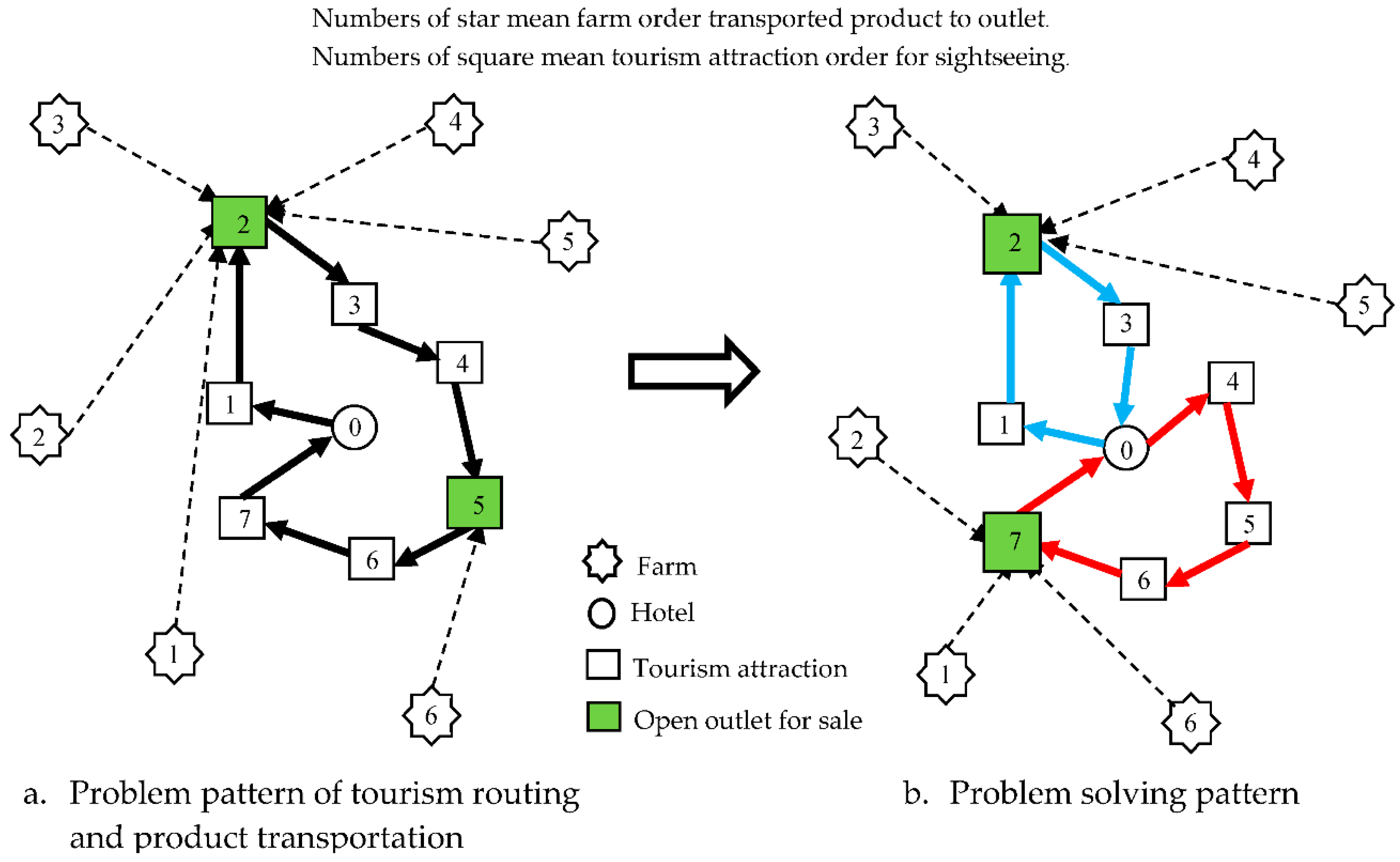


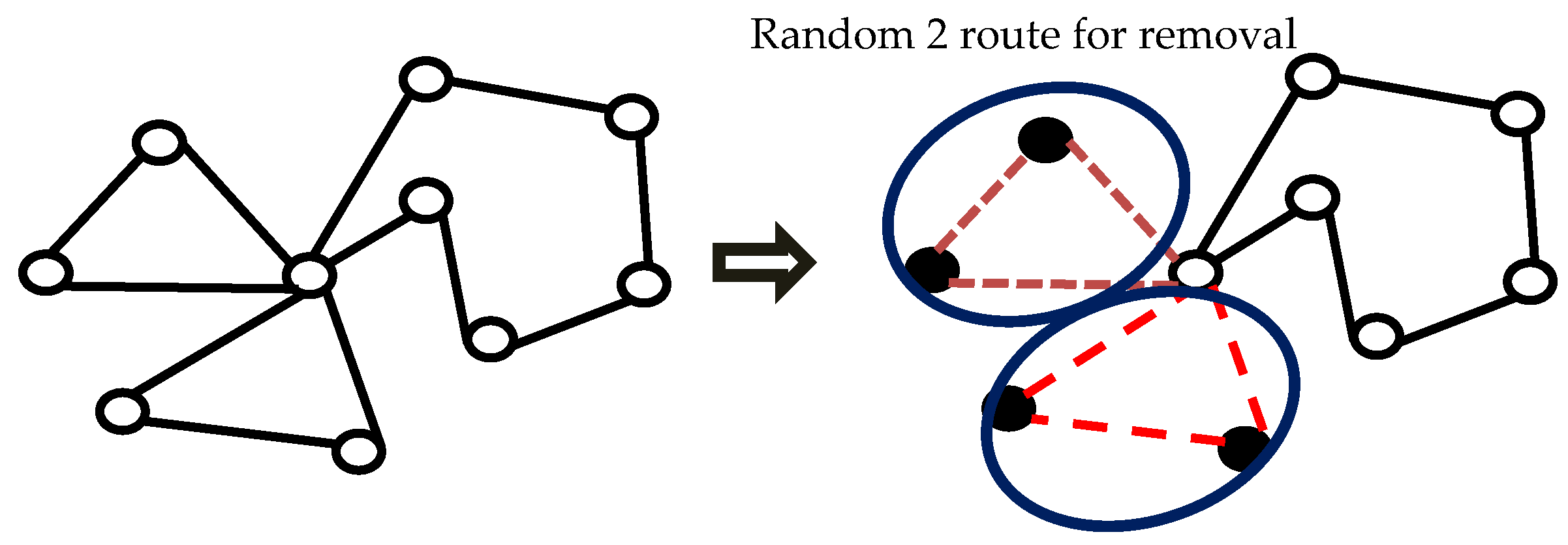



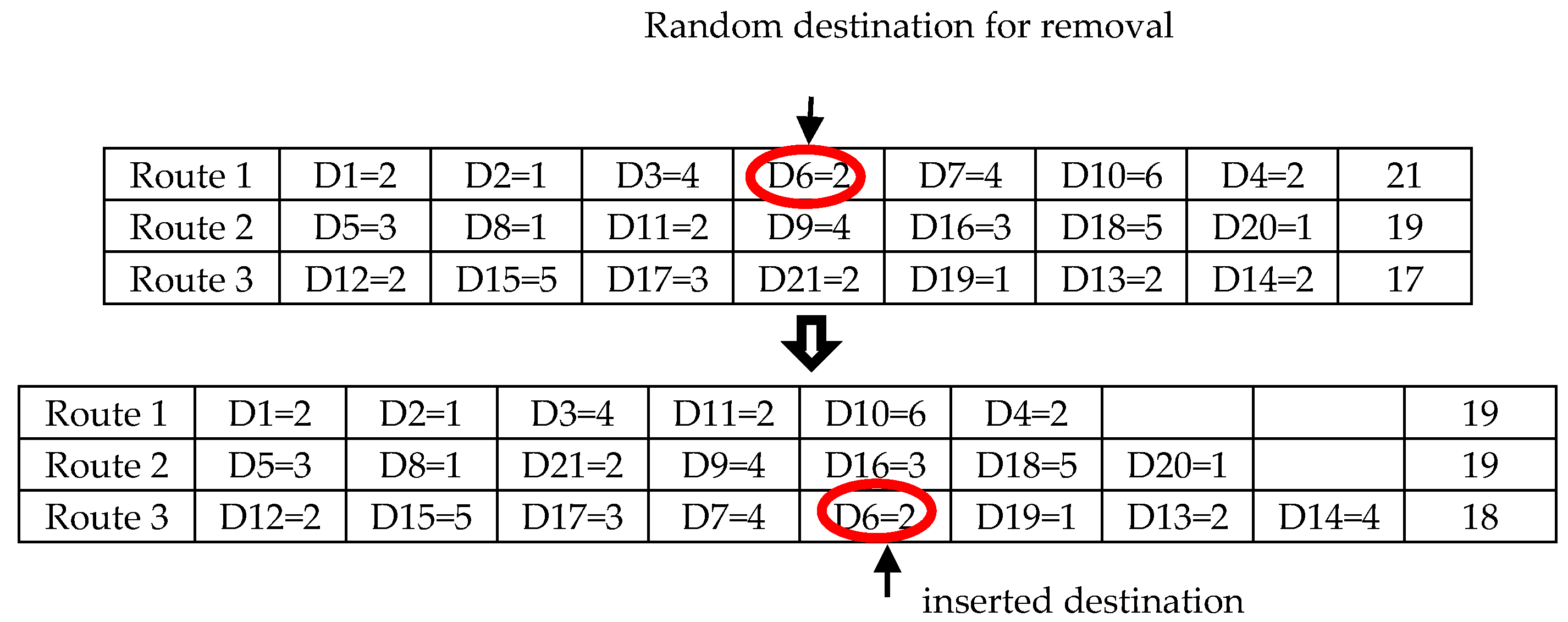

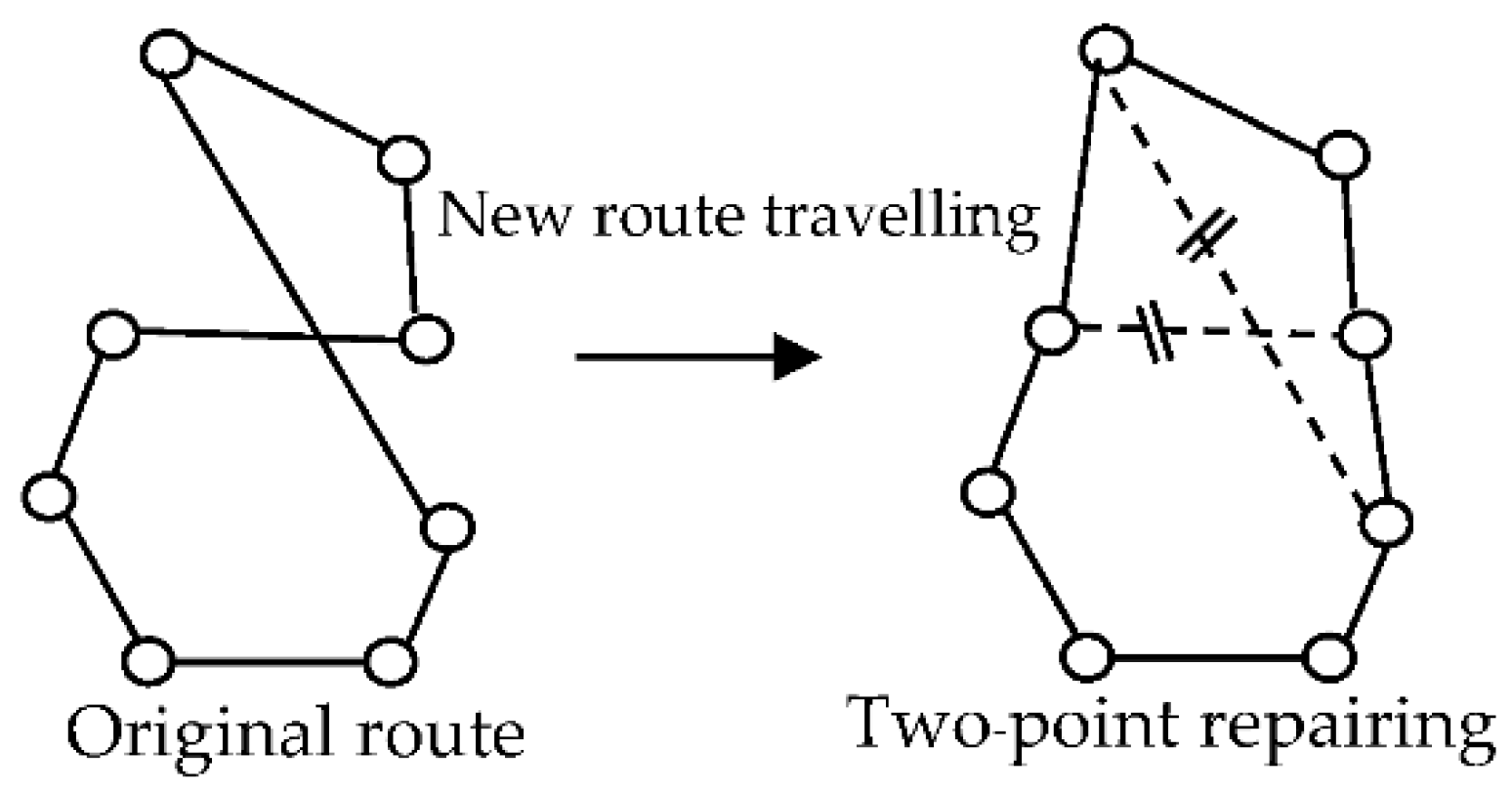
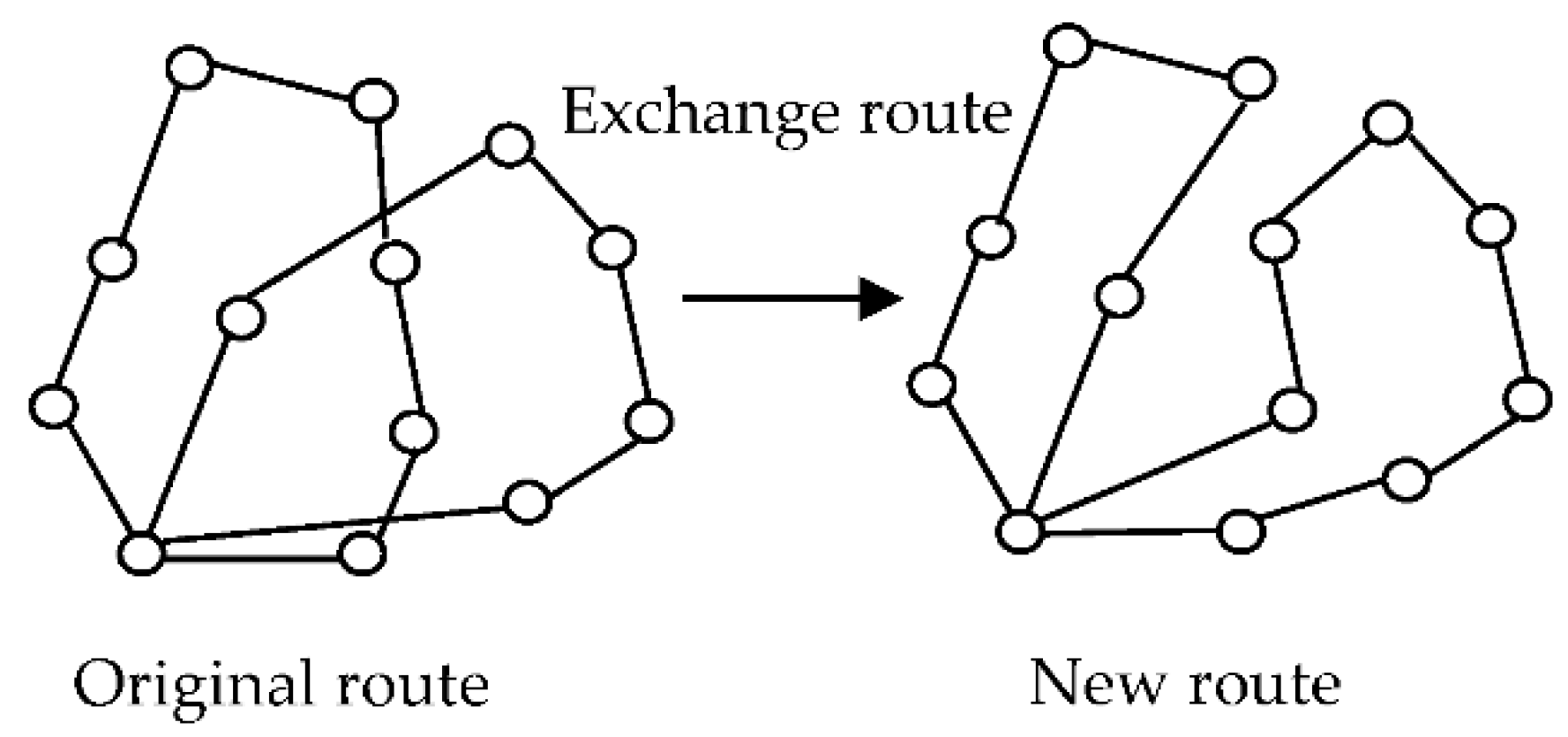
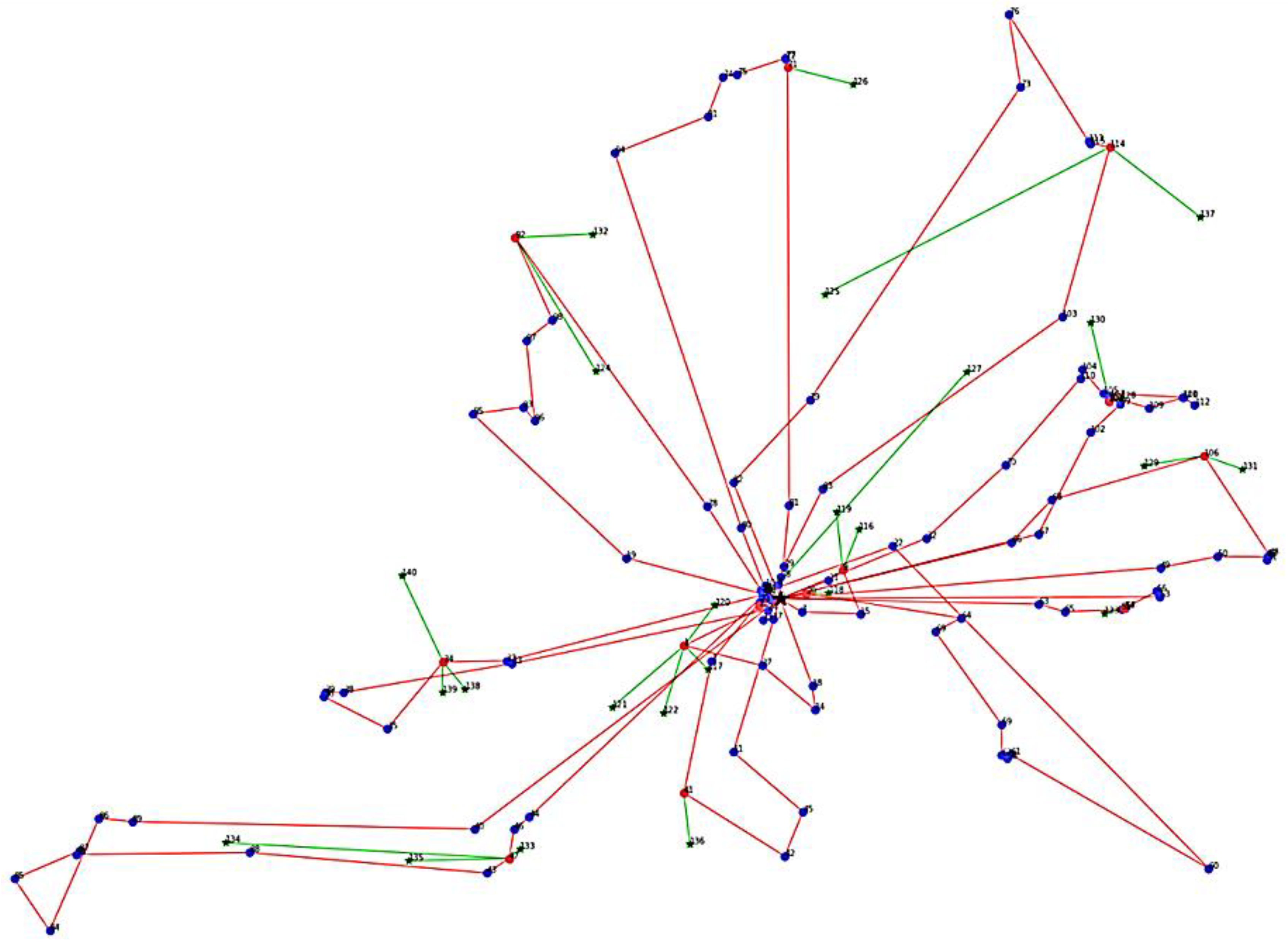
| Study | Topic | Approach | % Gap | ||||||||
|---|---|---|---|---|---|---|---|---|---|---|---|
| TTN | GA | DE | TS | NNW | PTA | RA | CSCRA | LP | |||
| Wang et al. (2018) | Electric vehicle tour planning | ✔ | 0 | ||||||||
| Lim et al. (2018) | Tour recommendation and itinerary planning | ✔ | 2.5–15 | ||||||||
| Liao and Zheng (2018) | Tourist trip design problem; TTDP | ✔ | ✔ | 1.98–13.10 | |||||||
| Wu et al. (2017) | Tour route planning problem | ✔ | - | ||||||||
| Nedjati et al. (2017) | Tour location routing problem | ✔ | - | ||||||||
| Kotiloglu et al. (2017) | Multi-period tour | ✔ | 0.04 | ||||||||
| Zheng et al. (2017) | Design personalized day tour route | ✔ | ✔ | 3.50–5.85 | |||||||
| Xiao et al. (2017) | Tourism route planning | ✔ | - | ||||||||
| Gavalas et al. (2014) | Time-dependent team orienteering problem | ✔ | 3.4–14 | ||||||||
| Rodríguez et al. (2012) | Development of tool for individual tourists | ✔ | 2.17–4.28 | ||||||||
| Zhu et al. (2012) | Tour planning problem | ✔ | 0.12–2.84 | ||||||||
| Problem Size | No. | Parameter | Lingo Program | ALNS | Difference | |||||||
|---|---|---|---|---|---|---|---|---|---|---|---|---|
| Result | Result | |||||||||||
| i, j | f | Status | Total Distance (km) | Processing Time (h) | Total Distance (km) | Processing Time (h) | Total Distance (km) | Processing Time (h) | Gap in Distance Traveled (%) | Processing Time Gap (%) | ||
| Small | S-1 | 10 | 5 | Global Opt | 109.90 | 00:00:01 | 109.90 | 00:00:01 | 0 | 0 | 0.0 | 0.0 |
| S-2 | 10 | 5 | Global Opt | 164.40 | 00:00:01 | 164.40 | 00:00:01 | 0 | 0 | 0.0 | 0.0 | |
| S-3 | 10 | 5 | Global Opt | 302.60 | 00:00:33 | 302.60 | 00:00:33 | 0 | 0 | 0.0 | 0.0 | |
| S-4 | 10 | 5 | Global Opt | 308.73 | 00:00:58 | 308.73 | 00:00:58 | 0 | 0 | 0.0 | 0.0 | |
| S-5 | 10 | 5 | Global Opt | 286.60 | 00:00:37 | 286.60 | 00:00:37 | 0 | 0 | 0.0 | 0.0 | |
| Average | 234.45 | 00:00:24 | 234.45 | 00:00:24 | 234.45 | 0 | 0.0 | 0.0 | ||||
| Medium | M-1 | 40 | 15 | Feasible | 898.65 | 40:59:27 | 901.50 | 00:05:05 | −2.85 | 40:54:22 | −0.32 | 99.88 |
| M-2 | 40 | 15 | Feasible | 1157.84 | 60:17:21 | 1161.01 | 00:05:05 | −3.17 | 60:12:16 | −0.27 | 99.92 | |
| M-3 | 40 | 15 | Feasible | 997.78 | 41:49:13 | 1002.37 | 00:05:55 | −4.59 | 41:43:46 | −0.46 | 99.88 | |
| M-4 | 40 | 15 | Feasible | 1131.47 | 55:56:29 | 1153.50 | 00:05:25 | −22.03 | 55:51:02 | −1.95 | 99.91 | |
| M-5 | 40 | 15 | Feasible | 992.78 | 50:49:25 | 1018.52 | 00:05:45 | −25.74 | 50:44:20 | −2.59 | 99.90 | |
| Average | 1035.70 | 49:45:24 | 1047.38 | 00:05:25 | −11.68 | 49:40:28 | −1.12 | 99.90 | ||||
| Large | L-1 | 80 | 25 | Lower bound | 2058.56 | >120 | 2077.58 | 00:14:48 | −19.02 | 119:51:52 | −0.92 | 99.88 |
| L-2 | 80 | 25 | Lower bound | 1938.81 | >120 | 1987.10 | 00:13:46 | −48.29 | 119:50:54 | −2.49 | 99.89 | |
| L-3 | 80 | 25 | Lower bound | 2076.52 | >120 | 2099.13 | 00:15:54 | −22.61 | 119:51:46 | −1.09 | 99.87 | |
| L-4 | 80 | 25 | Lower bound | 1965.64 | >120 | 1973.07 | 00:14:51 | −7.43 | 119:50:49 | −0.38 | 99.88 | |
| L-5 | 80 | 25 | Lower bound | 2087.31 | >120 | 2092.70 | 00:15:43 | −5.39 | 119:50:57 | −0.26 | 99.87 | |
| Average | 2025.37 | 120 | 2045.92 | 00:14:54 | −20.55 | 119:50:48 | −1.03 | 99.88 | ||||
| Problem Size | p-Value | |
|---|---|---|
| Total Traveling Distance | Processing Time | |
| Small | 1.000 | 1.000 |
| Medium | 0.081 | 0.000 * |
| Large | 0.055 | 0.000 * |
| Problem | Route | Destinations | Outlet Locations | Farms | Distance (km) | Distant Total (km) |
|---|---|---|---|---|---|---|
| Case study | 1 | 0-7-15-9-21-0 | 9 | 4,1 | 55.60 | 2538.02 |
| 2 | 0-81-71-72-77-75-74-91-94-80-3-0 | 71 | 11 | 279.40 | ||
| 3 | 0-8-28-29-83-103-114-115-113-76-73-79-82-0 | 114 | 22,10 | 379.80 | ||
| 4 | 0-49-50-52-51-48-106-68-66-0 | 106 | 16,14 | 171.95 | ||
| 5 | 0-1-27-14-18-0 | 1 | 2,6,7,5 | 119.63 | ||
| 6 | 0-67-102-99-105-111-112-100-109-107-108-101-104-110-70-32-0 | 108 | 13,15 | 202.79 | ||
| 7 | 0-11-45-42-41-2-23-0 | 41 | 21 | 209.70 | ||
| 8 | 0-16-44-46-47-43-88-90-87-85-84-86-89-40-0 | 47 | 20,18 | 337.50 | ||
| 9 | 0-25-26-22-60-61-58-62-59-69-64-20-0 | 20 | 19,3 | 184.40 | ||
| 10 | 0-19-95-93-96-97-98-92-78-30-4-0 | 92 | 17,9 | 234.60 | ||
| 11 | 0-10-31-5-37-34-35-36-39-38-33-24-0 | 34 | 25,24,23 | 201.85 | ||
| 12 | 0-63-65-55-57-54-56-53-0 | 54 | 8 | 133.40 | ||
| 13 | 0-13-17-12-6-0 | 12 | 12 | 27.40 |
© 2018 by the authors. Licensee MDPI, Basel, Switzerland. This article is an open access article distributed under the terms and conditions of the Creative Commons Attribution (CC BY) license (http://creativecommons.org/licenses/by/4.0/).
Share and Cite
Sirirak, W.; Pitakaso, R. Marketplace Location Decision Making and Tourism Route Planning. Adm. Sci. 2018, 8, 72. https://doi.org/10.3390/admsci8040072
Sirirak W, Pitakaso R. Marketplace Location Decision Making and Tourism Route Planning. Administrative Sciences. 2018; 8(4):72. https://doi.org/10.3390/admsci8040072
Chicago/Turabian StyleSirirak, Worapot, and Rapeepan Pitakaso. 2018. "Marketplace Location Decision Making and Tourism Route Planning" Administrative Sciences 8, no. 4: 72. https://doi.org/10.3390/admsci8040072
APA StyleSirirak, W., & Pitakaso, R. (2018). Marketplace Location Decision Making and Tourism Route Planning. Administrative Sciences, 8(4), 72. https://doi.org/10.3390/admsci8040072





